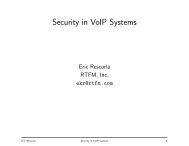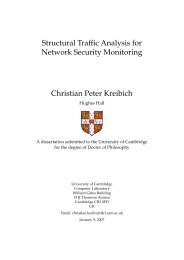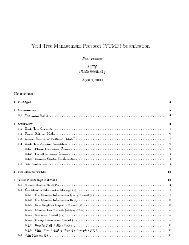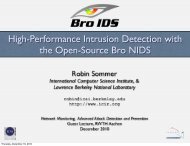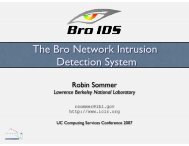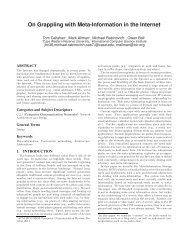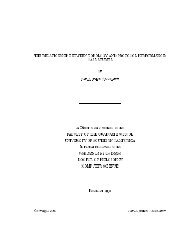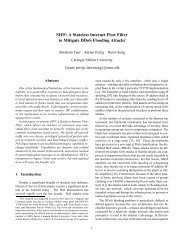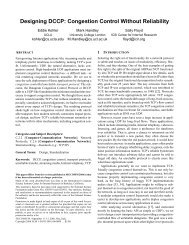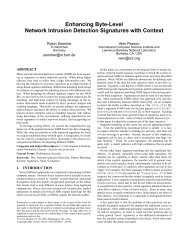Characteristics of Internet Background Radiation - UNC Computer ...
Characteristics of Internet Background Radiation - UNC Computer ...
Characteristics of Internet Background Radiation - UNC Computer ...
You also want an ePaper? Increase the reach of your titles
YUMPU automatically turns print PDFs into web optimized ePapers that Google loves.
Number <strong>of</strong> Source Hosts<br />
10000<br />
9000<br />
8000<br />
7000<br />
6000<br />
5000<br />
4000<br />
3000<br />
2000<br />
1000<br />
445/Locator<br />
80/SrchAAA<br />
135/RPC exploit (1464 bytes)<br />
445/Sasser ("lsarpc")<br />
0<br />
0 2 4 6 8 10 12 14 16<br />
Time (day)<br />
Figure 11: The Big Exploits (Apr 20 to May 7, 2004), as observed<br />
on 5 /C networks at LBL. The source hosts are counted<br />
every three hours.<br />
the application semantic level.<br />
5.2 Temporal Distribution <strong>of</strong> Activities<br />
We will examine two cases <strong>of</strong> temporal activity. First, we will<br />
look at the exploits with the largest source population and consider<br />
the distributional variation over time; Second, we look at the exploits<br />
targeted at a particular vulnerability and consider how these<br />
exploits evolve and diversify over time. We will focus on the LBL<br />
network for this analysis.<br />
5.2.1 The Dominant Exploits<br />
Figure 11 shows how the numbers <strong>of</strong> source hosts vary over the<br />
course <strong>of</strong> 18 days for the four exploits with largest source population.<br />
The source volumes for the SrchAAA and Locator exploits are<br />
relatively stable and close to each other over time. This is not<br />
surprising because these exploits are likely coming from the same<br />
worm, as we will see in Section 6.2.<br />
The other two exploits, Exploit1464 and Sasser, show much a<br />
wider range <strong>of</strong> source volume dynamics — this is especially true<br />
for Exploit1464, which temporarily retreated to a much smaller<br />
scale around April 30th.<br />
All four exploits demonstrate a strong diurnal pattern, with obvious<br />
peaks at local time noon. We do not have good explanations<br />
for this pattern. For SrchAAA, Locator, and the Sasser exploits,<br />
the peak might be due to hosts being turned on at daytime and doing<br />
local-biased search. However, for Exploit1464, the steep narrow<br />
peaks lead us to believe they could be caused by the scanning<br />
mechanism itself.<br />
5.2.2 DCE/RPC Exploits<br />
DCE/RPC exploits that target the Micros<strong>of</strong>t DCOM RPC vulnerability<br />
[37] present an interesting case <strong>of</strong> a single well-known<br />
vulnerability being used and reused by various worms and/or autorooters.<br />
This vulnerability is particularly attractive because it exists<br />
on every unpatched Windows 2000/XP system, in contrast to, e.g.<br />
vulnerabilities that exist only on IIS or SQL servers.<br />
We have seen quite a few different exploit payloads in this data.<br />
There are at least 11 different payload lengths. This does not appear<br />
to be result <strong>of</strong> intentional polymorphism, for two reasons: 1) from<br />
almost every single source IP we see only one payload length; and<br />
2) it would be easy to vary the length <strong>of</strong> payload by simply inserting<br />
NOP’s if the adversary wanted to incorporate some polymorphism.<br />
Thus we infer that the diversity <strong>of</strong> payloads is not due to deliberate<br />
polymorphism but due to different code bases. While the payloads<br />
themselves might not be very interesting, since the diversity<br />
is likely due to the various “shell code” they carry, the diversity <strong>of</strong>fers<br />
us an opportunity to look at the rising and ebbing <strong>of</strong> different<br />
exploit programs.<br />
Without a robust way to cluster payloads by contents (payloads<br />
<strong>of</strong> same length sometimes differ on tens to hundreds bytes and the<br />
differences are not merely byte shifting), we choose to cluster the<br />
exploits by lengths and the ports on which they appear, including<br />
port 135/1025 and the Epmapper pipes on port 445/139. Under this<br />
scheme, we see more than 30 different exploit types. We select 9<br />
<strong>of</strong> the popular exploits and consider how the number <strong>of</strong> source IP<br />
addresses for each exploit varies over time during April 2004. The<br />
exploits have 4 different payload lengths: 1448, 1464, 2972, and<br />
2904, and are seen on port 135, 1025, and 445.<br />
We observe strong temporal correlation among exploits <strong>of</strong> the<br />
same length for lengths 2792 and 2904, while this is not the case<br />
for lengths 1448 and 1464. The four exploits also show some correlation<br />
in terms <strong>of</strong> activity to port 135 and to port 445, which is<br />
due to the same source probing both ports. We also find that even<br />
for multiple sources, activity for particular port/length pairs tends<br />
to come in bursty spikes, suggesting synchronized scanning among<br />
the sources.<br />
6. CHARACTERISTICS OF SOURCES<br />
In this section we examine the background radiation activities in<br />
terms <strong>of</strong> source hosts. We associate various activities coming from<br />
the same source IP to construct an “activity vector” for each source<br />
IP, which we then examine in three dimensions: 1) across ports,<br />
2) across destination networks, and 3) over time.<br />
There is a caveat about identifying hosts with IP addresses: due<br />
to DHCP, hosts might be assigned different addresses over time. A<br />
study [21] concluded that “IP addresses are not an accurate measure<br />
<strong>of</strong> the spread <strong>of</strong> a worm on timescales longer than 24 hours”.<br />
However, without a better notion to identify hosts, we will still use<br />
IP addresses to identify hosts, while keeping this caveat in mind.<br />
6.1 Across Ports<br />
Associating activities across ports sometimes gives us a significantly<br />
better picture <strong>of</strong> a source’s goals. This especially helps with<br />
analyzing puzzling activities, because it puts behavior on individual<br />
ports in the context <strong>of</strong> collective activity. For example, simply<br />
looking at an RPC exploit may not readily reveal the worm or autorooter<br />
that sends it, but once we see a follow-up to port 4444 with<br />
"tftp msblast.exe", we know that the earlier exploit comes<br />
from Blaster.<br />
Table 9 provides a summary <strong>of</strong> the top multi-port scanning<br />
episodes seen in the four networks. The most common is sources<br />
that scan both 139 and 445. Many viruses that exploit Net-<br />
BIOS/SMB (CIFS) exhibit this behavior since for propagation the<br />
ports can be used interchangeably. This next most common multiport<br />
source behavior exploits the Micros<strong>of</strong>t DCE/RPC vulnerability<br />
[37] both via port 135 and by connecting to the Epmapper pipe<br />
through port 139 and port 445 during the same episode. These are<br />
likely variants <strong>of</strong> Welchia. Most port 5000 connections are empty<br />
and the rest small portion <strong>of</strong> them look like buffer overrun exploits.<br />
We also find Agobot variants that occasionally target these services.<br />
They connect to the SAMR pipe through CIFS to obtain registry information,<br />
following the sequence described in Figure 4 and drop<br />
the file mdms.exe into one <strong>of</strong> the startup folders. The least common<br />
pr<strong>of</strong>iles are used exclusively by Agobot variants (I, II and III).




